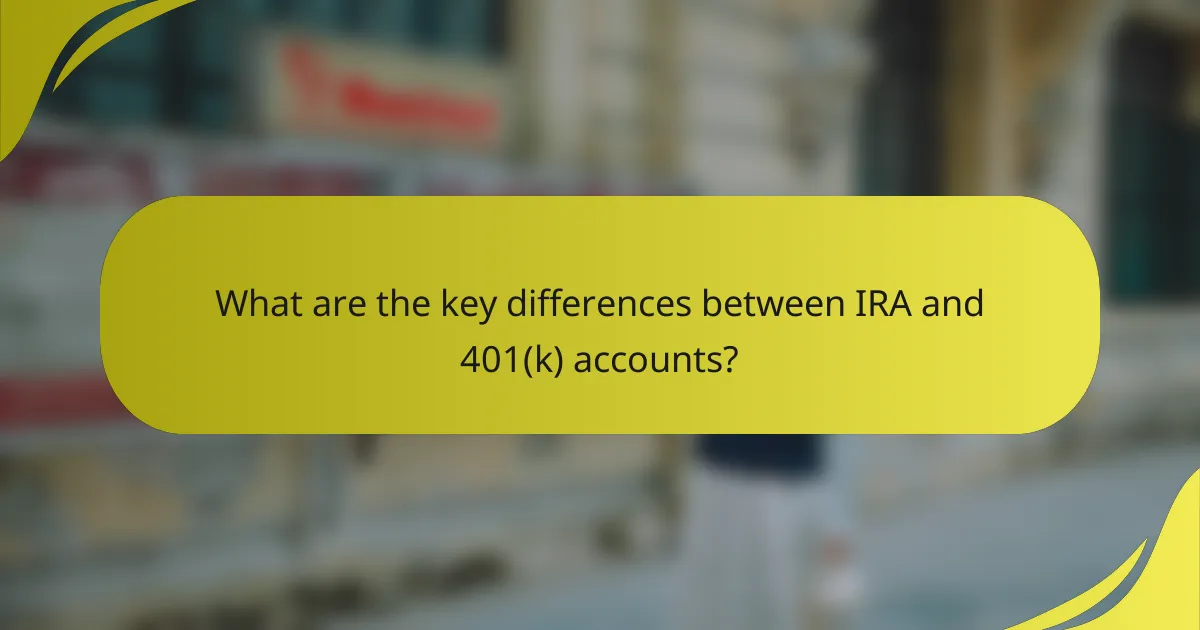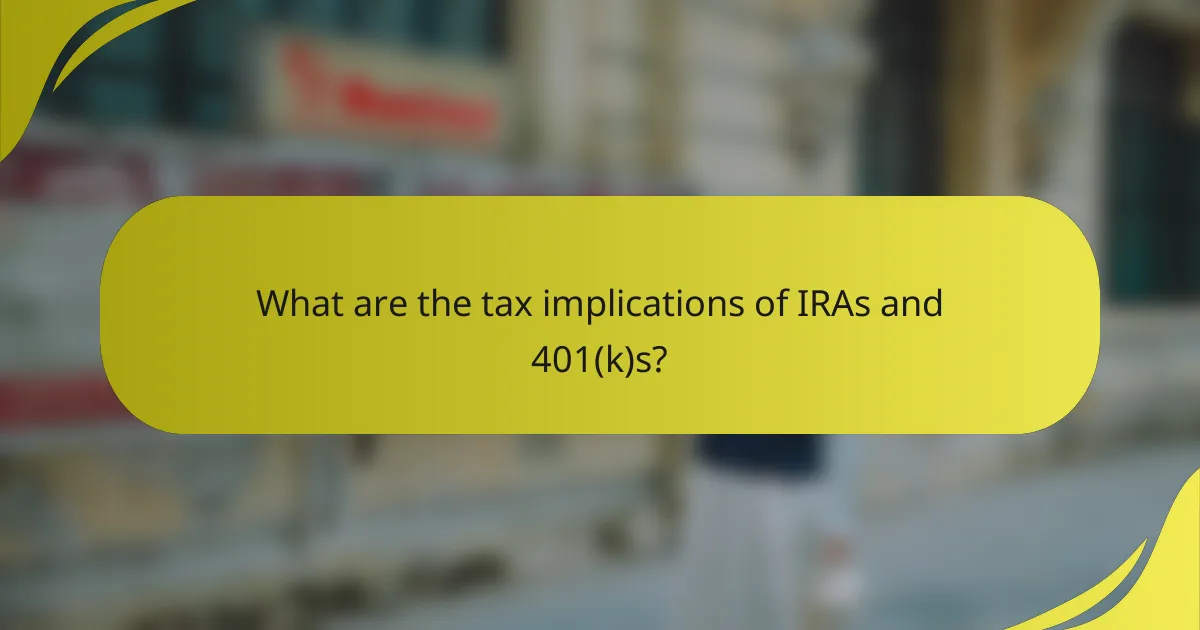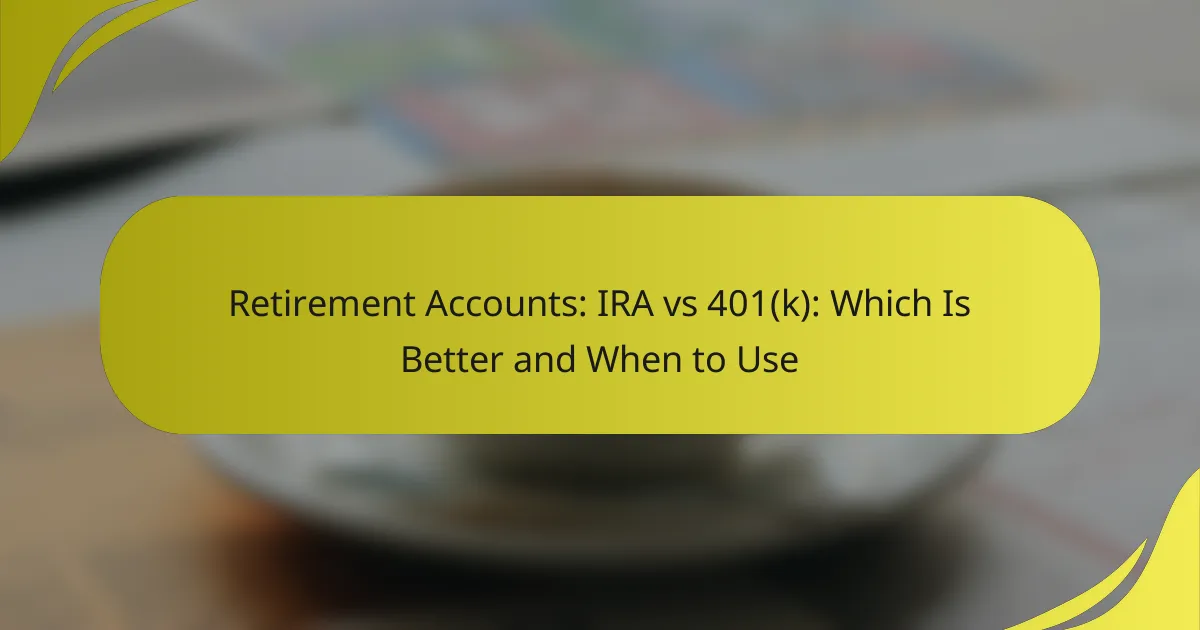When planning for retirement, understanding the differences between IRA and 401(k) accounts is crucial for making informed decisions. While both options offer unique benefits, such as varying contribution limits and tax treatments, your choice may depend on factors like employer matching and investment flexibility. Evaluating your financial situation and retirement goals will help you determine which account is better suited for your needs.

What are the key differences between IRA and 401(k) accounts?
IRA and 401(k) accounts are both popular retirement savings options, but they differ significantly in terms of contribution limits, tax treatment, withdrawal rules, employer matching, and investment options. Understanding these differences can help you choose the right account for your retirement planning needs.
Contribution limits
Contribution limits vary between IRA and 401(k) accounts. For 2023, individuals can contribute up to $6,500 to an IRA, or $7,500 if they are age 50 or older. In contrast, 401(k) plans allow contributions of up to $22,500, with a catch-up contribution of $7,500 for those aged 50 and above.
These limits can influence your decision based on how much you plan to save for retirement. If you want to maximize your contributions, a 401(k) might be more suitable, especially if your employer offers matching contributions.
Tax treatment
The tax treatment of IRA and 401(k) accounts differs significantly. Traditional IRAs allow for tax-deductible contributions, meaning you pay taxes on withdrawals during retirement. Conversely, 401(k) contributions are made pre-tax, reducing your taxable income in the year you contribute.
Roth IRAs, another type of IRA, require after-tax contributions but allow tax-free withdrawals in retirement. Choosing between these options depends on your current tax situation and expectations for future tax rates.
Withdrawal rules
Withdrawal rules for IRAs and 401(k)s also vary. Generally, you can begin withdrawing from both accounts without penalty at age 59½. However, IRAs allow for penalty-free withdrawals under certain circumstances, such as for first-time home purchases or qualified education expenses.
401(k) plans may have stricter rules regarding withdrawals, often requiring you to meet specific conditions or face penalties. Understanding these rules is crucial for planning your retirement income strategy.
Employer matching
Employer matching is a key advantage of 401(k) plans. Many employers offer to match a portion of your contributions, effectively providing you with free money for retirement. This can significantly boost your savings over time.
IRAs do not have employer matching, so if you have access to a 401(k) with a match, it’s often advisable to contribute enough to take full advantage of that benefit before considering an IRA.
Investment options
Investment options differ between IRAs and 401(k)s. IRAs typically offer a broader range of investment choices, including stocks, bonds, mutual funds, and ETFs. This flexibility allows for more personalized investment strategies.
401(k) plans usually have a limited selection of investment options determined by the employer, which may restrict your ability to diversify. When choosing between the two, consider how much control you want over your investments.

When should you choose an IRA over a 401(k)?
Choosing an IRA over a 401(k) is often beneficial for individuals seeking more control over their retirement savings and investment options. IRAs can be particularly advantageous for self-employed individuals, lower income earners, and those who desire greater investment flexibility.
Self-employed individuals
Self-employed individuals may find IRAs more suitable due to their ability to contribute without the restrictions of an employer-sponsored plan. A Simplified Employee Pension (SEP) IRA allows for higher contribution limits, which can be beneficial for those with fluctuating incomes. Additionally, traditional and Roth IRAs offer options for tax advantages that can align well with self-employment income.
Lower income earners
Lower income earners might prefer IRAs because they often have lower fees and minimum balance requirements compared to 401(k) plans. A Roth IRA, in particular, allows contributions to be made with after-tax dollars, which can be advantageous if you expect to be in a higher tax bracket in retirement. Furthermore, the ability to withdraw contributions tax-free can provide financial flexibility for those with limited income.
More investment flexibility
IRAs typically offer a wider range of investment options compared to 401(k) plans, which are often limited to a selection of mutual funds. With an IRA, you can invest in stocks, bonds, ETFs, and even real estate, depending on the custodian. This flexibility allows you to tailor your investment strategy to your specific risk tolerance and financial goals, making it easier to diversify your portfolio effectively.

When is a 401(k) the better option?
A 401(k) is often the better choice when your employer offers matching contributions, higher contribution limits, and automatic payroll deductions. These features can significantly enhance your retirement savings potential compared to an IRA.
Employer matching benefits
Employer matching benefits can substantially boost your retirement savings. Many companies match employee contributions up to a certain percentage, often around 3% to 6% of your salary. This means if you contribute to your 401(k), your employer will add additional funds, effectively giving you free money for retirement.
To maximize this benefit, aim to contribute at least enough to receive the full match. Failing to do so is essentially leaving money on the table, which can hinder your long-term savings growth.
Higher contribution limits
401(k) plans typically allow for higher contribution limits compared to IRAs. For 2023, the contribution limit for a 401(k) is $22,500, with an additional catch-up contribution of $7,500 for those aged 50 and older. In contrast, the IRA contribution limit is significantly lower, capped at $6,500, with a $1,000 catch-up option.
This higher limit in a 401(k) enables you to save more aggressively for retirement, especially if you are in your peak earning years. Consider maximizing your contributions to take full advantage of this benefit.
Automatic payroll deductions
Automatic payroll deductions make it easier to save consistently for retirement through a 401(k). Contributions are deducted directly from your paycheck, which simplifies the saving process and helps you avoid the temptation to spend that money elsewhere.
Setting up automatic contributions can lead to better financial discipline. You can start with a percentage of your salary that you are comfortable with and increase it over time as your financial situation improves.

What are the tax implications of IRAs and 401(k)s?
The tax implications of IRAs and 401(k)s vary significantly, affecting how and when you pay taxes on your retirement savings. Generally, contributions to these accounts can be tax-deductible, but the tax treatment of withdrawals differs between the two types of accounts.
Traditional vs Roth options
Both IRAs and 401(k)s offer traditional and Roth options, which determine when you pay taxes. Traditional accounts allow for tax-deductible contributions, meaning you pay taxes on withdrawals during retirement. In contrast, Roth accounts require contributions to be made with after-tax dollars, allowing for tax-free withdrawals in retirement.
Choosing between traditional and Roth options depends on your current tax rate versus your expected tax rate in retirement. If you anticipate being in a higher tax bracket later, a Roth account may be more beneficial.
Early withdrawal penalties
Withdrawing funds from an IRA or 401(k) before the age of 59.5 typically incurs a penalty of 10% on the amount withdrawn, in addition to regular income taxes. However, there are exceptions for certain circumstances, such as first-time home purchases or qualified education expenses for IRAs.
For 401(k)s, some plans allow for loans or hardship withdrawals, which can mitigate penalties but may still have tax implications. Always check your specific plan rules before considering an early withdrawal.
Tax-deferred growth
Both IRAs and 401(k)s offer tax-deferred growth, meaning your investments can grow without being taxed until withdrawal. This allows for potentially greater compounding over time, as you can reinvest the money that would otherwise go to taxes.
It’s essential to maximize contributions to these accounts to take full advantage of tax-deferred growth. For 2023, the contribution limits are $6,500 for IRAs and $22,500 for 401(k)s, with additional catch-up contributions available for those aged 50 and older.

How do IRAs and 401(k)s affect retirement planning?
IRAs and 401(k)s are essential tools for retirement planning, each offering unique benefits and considerations. Understanding how they work can help you maximize your savings and ensure a stable income during retirement.
Retirement income sources
Both IRAs and 401(k)s serve as primary sources of retirement income, but they differ in structure and contribution limits. A 401(k) is employer-sponsored, allowing for higher annual contributions, often matched by employers, while IRAs are individually managed with lower contribution limits.
When planning for retirement, consider diversifying your income sources. Relying solely on one type of account may limit your financial flexibility. Combining both IRAs and 401(k)s can provide a more robust retirement income strategy.
Long-term savings strategies
Utilizing IRAs and 401(k)s effectively requires a long-term savings strategy. For instance, contributing the maximum allowable amount to your 401(k) can significantly enhance your retirement savings due to employer matches and tax advantages.
On the other hand, IRAs offer more investment options, which can be advantageous for those looking to diversify their portfolios. Regularly reviewing and adjusting your contributions based on your financial situation and retirement goals is crucial for optimizing your savings.

What are the common mistakes to avoid with retirement accounts?
Common mistakes with retirement accounts can significantly impact your savings. Awareness of these pitfalls can help you maximize your investment and secure a better financial future.
Neglecting employer match
One of the most significant mistakes is failing to take full advantage of an employer match in a 401(k) plan. Many employers offer to match contributions up to a certain percentage, which is essentially free money. If you do not contribute enough to receive the full match, you are leaving potential savings on the table.
To avoid this mistake, aim to contribute at least enough to get the full match. For example, if your employer matches 50% of your contributions up to 6% of your salary, make sure to contribute at least 6% to maximize your benefits.
Ignoring fees
Another common error is overlooking the fees associated with retirement accounts. High fees can erode your investment returns over time, significantly impacting your savings. It’s essential to understand the fee structure of your accounts, including management fees, fund expense ratios, and any other charges.
To mitigate this issue, compare the fees of different investment options within your retirement accounts. Aim for low-cost index funds or ETFs, which typically have lower fees than actively managed funds. Regularly review your account statements to ensure you are not paying excessive fees that could hinder your retirement savings growth.



